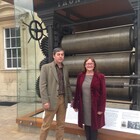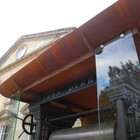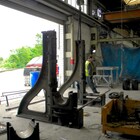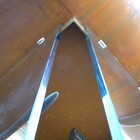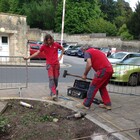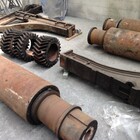Bradford-on-Avon Museum & Preservation Trust commissioned us to design a canopy for the Iron Duke, the first ‘calender machine’ used to roll sheet rubber and cotton together and vulcanise them.
The project which creates a bespoke enclosure of corten canopy & glass sides to the Duke was completed in the autumn of 2016.
The information page on the Museum website is here & an update here.
The Iron Duke story
This might look like a simple, straightforward commission, it was anything but!
We first saw the Iron Duke as three separate piles of oddly shaped ironwork buried deep in two Museum storage buildings. Pieces of the Iron Duke had lain in the Bristol Museum warehouses for 45 years, since it was dismantled in 1970. There was an aspiration for many years to return it to it’s original home in Bradford-on-Avon. In 2015 we won the commission from Bradford on Avon Preservation Trust to design an elegant enclosure as weather protection for this historic artefact to be restored to a new public setting, outside it’s original home next to Kingston House.
The Iron Duke is the original rubber bonding ‘calender’ machine used in the Kingston Mills Factory. It was commissioned by Stephen Moulton and in use from 1849 to 1970, making the famous Avon rubber. Named the ‘Iron Duke’ after the Duke of Wellington, it was probably the first machine in Europe to produce the resilient rubber, enabling the production of all manner of objects we now take for granted from vehicle tyres to tennis balls.
Our task was to design a prefabricated enclosure that would exactly fit the machine within the constricted enclosure. The problem was that there were no drawings of the Iron Duke or record of how it was dismantled. A couple of grainy old sepia photographs of the machine in use, surrounded by and connected to other components was all we had to go on. What constituted ‘the machine’ was not clear. Faced with this complex three dimensional jigsaw and only a vague notion of it’s final form, we decided to use a virtual model of each individual iron component, to build an accurate virtual model for it’s reconstruction.
The resultant drawings formed the basis of fund raising and the planning application for siting the structure in the grounds of the listed building.
Dorothea Restoration, the company tasked with rebuilding the machine, used our virtual reconstruction to piece together the real components from a myriad of storage boxes which they had collected from Bristol Museum. It also helped eliminate some pieces which, it became clear, had nothing to do with the Iron Duke but had been accidentally stored with them.
The 3.2 x 3.6 metre canopy was craned into position atop of the 3 metre high Iron Duke and temporarily braced until the glazing could be fitted - this was made to measure after the roof was put in place to ensure a perfect fit. The glass sizes were within 10mm of the predicted height thanks to the accurate virtual model.



